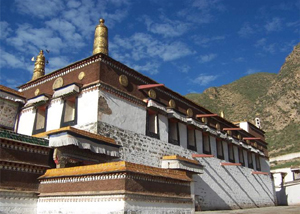 |
 |
Covering an area of around 82 hectares with a floor space of 82,300 square meters the Labrang Lamasery consists of 6 scripture-chanting halls, 84 Buddha halls, 31 Tibetan style buildings, 30 palace-yards for Buddhas and over 500 meditation rooms as well as more than 10,000 abodes for lamas. Together with Drepung, Sera, Ghandam, Tashilhunpo and Ta’er monasteries in Tibet and Qinghai, they are considered the six sovereign monasteries for the Yellow Sect (Gelugpa) of the Chinese Tibetan Buddhism. Labrang is a transliteration of a Tibetan word pronounced as “Lazhang”, which means a place for the location of a Buddhism palace.
Pooled together wisdoms of the Tibetan, Han and Mongolian people, the monastery is renowned for its exquisite art of architecture and brilliance of religious culture. Kept in the monastery are all kinds of sutras, dividing into complete works, philosophy, Esoteric Sect of Buddhism, medicine, history, religion, biography, building technology, mathematics and poem and prose, etc, a total of 12 categories in 60,000 volumes. It is a monastery with the greatest collection of books. The monastery also runs six academies for religious and other teachings and learning, such as the Esotericism and medicine and so on. So it is the largest academy of Lamaism in China and the world as well. With a strict system of enrollment, teaching, examination and graduation it has nurtured a great many religious personnel for the Tibetan speaking regions.
Cited from:(Han Rongliang & Han Zhiyu (2006). Guide to Gansu [M].Beijing: China Travel and Tourism Press)


